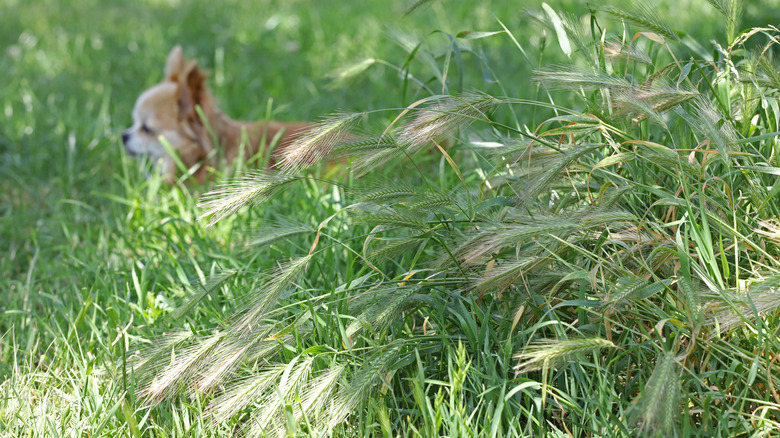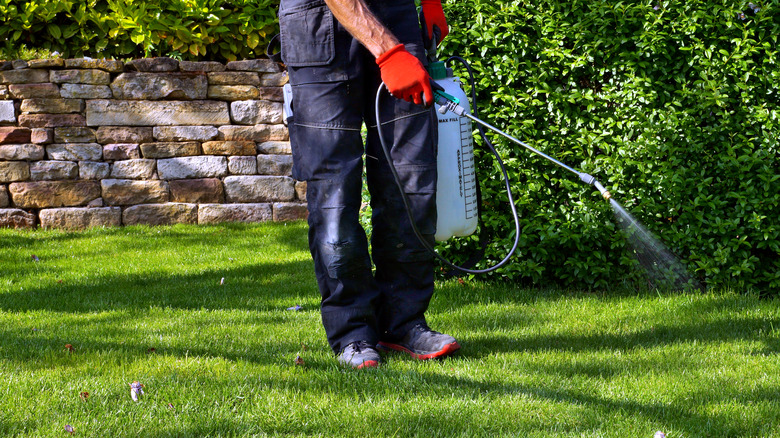Keep Invasive Green Foxtail Weeds At Bay With A Natural Ingredient
If you're starting to notice plants with flat leaves adorned with long bristles in your garden or lawn, you might be facing an invasion by the green foxtail. This common garden weed is not just an eyesore — it's a prolific seed producer capable of releasing around 34,000 seeds per plant. If you want to combat this invasive species, vinegar might be your greatest ally. A potent 20% vinegar solution has been shown to effectively destroy the leaves of this weed, attacking it right at its roots. This method isn't mere speculation: A 2002 study in the journal "Proceedings of Northeastern Weed Science Society" provides strong scientific support, revealing that vinegar concentrations of 5-10% can successfully eradicate young foxtail weeds within their first two weeks of life, while more mature plants require higher (15-20%) concentrations to achieve the same effect. This insight makes vinegar a compelling, natural solution for managing your foxtail problem.
Originating from the grassy plains of Eurasia, green foxtail has adapted to a wide range of climates, making it a common nuisance across many parts of the world. Despite the plant's slow germination rate and its struggle to compete in less dense environments, its propensity to flourish and propagate quickly in warm, light-rich conditions means it can quickly dominate a lawn or garden if not addressed promptly. Understanding how vinegar works against this weed and how to properly apply it is crucial for reclaiming your garden from this invasive pest.
Why vinegar works
What makes vinegar such a standout treatment for green foxtail? Well, it all boils down to acetic acid, its star component. When you douse those pesky plants with it, acetic acid goes to work by breaking down plant cells and releasing essential fluids. This dehydrates the plant, leading to its death. This mechanism of action is quick and packs a punch, offering a greener alternative to the harsh chemicals found in many herbicides. It's also crucial to note that the strength of the vinegar — or rather, the amount of acetic acid it contains — plays a big role in its effectiveness against weeds.
Your typical pantry vinegar has about a 5% concentration of acetic acid, which might do the trick for the smaller, younger weeds. But when you're up against the tougher, more established green foxtail weeds, you'll want to reach for the vinegar varieties that pack at least 15-20% acetic acid punch. Per the 2002 "Proceedings" study, these stronger concentrations can wipe out foxtail weeds at every stage of growth, boasting an impressive 95% to 100% success rate (go for 30% if you can for even more effectiveness). However, it's crucial to note that vinegar's reach might not extend all the way to the roots, and if you don't get full coverage, those weeds could make an unwelcome comeback. The younger the weed — especially those in the two- to four-leaf stage — the better the vinegar solution works, as it can fully coat the leaves and cut off the weed's chances of bouncing back.
How to use it against green foxtail weed
To whip up a potent vinegar-based herbicide, you'll need to mix 1 gallon of vinegar (aiming for a 5% acetic acid content or higher) with a cup of Castile soap. The soap serves an important role here — it's a surfactant, which means it lowers the surface tension of the vinegar mixture, helping it cling to the foxtail weed's leaves much more effectively. This ensures that the vinegar remains in contact with the weed long enough to do its job thoroughly. If you're thinking about giving this method a whirl, be sure to coat every leaf with the solution to prevent any chance of regrowth. Given that green foxtail is an annual weed, a diligent application of this vinegar solution should keep your garden foxtail-free until the cycle tries to start anew.
Understanding foxtail weed's lifecycle is also key for effective elimination. These seeds start sprouting when the weather hits the sweet spot between 20 and 25 degrees Celsius, typically from the end of May to the start of June. Yet, don't let your guard down, as these seeds can keep popping up through September, especially with a little encouragement from rainfall and damp soil. Lastly, note that acetic acid does not remain active in the soil, meaning it only affects the plants it comes into direct contact with and does not prevent future weeds from germinating. Therefore, repeated applications may be necessary to control new foxtail weeds as they emerge.


